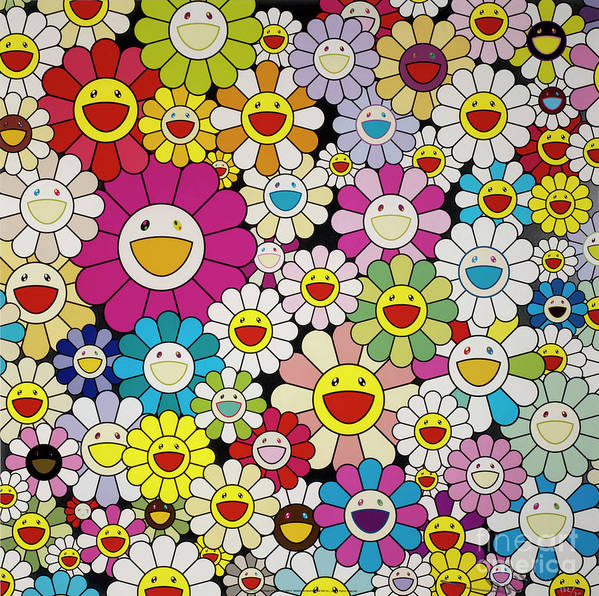Two separate universes emerge in the kaleidoscope world of contemporary art, each with a soul-grabbing tale. Japanese artist Takashi Murakami, a visionary, welcomes us into his colorful world filled with recognizable flowers. African American women artists, who are frequently disregarded despite their undeniable influence, use their artistry to negotiate the difficult terrain of social justice, history, and identity.
In this article, Takashi Murakami flower and the tenacious canvases of African American women artists are examined as we delve into the significant artistic accomplishments of both.
Studying the Superflat Floral Iconography of Takashi Murakami
With its brilliant petals and endearing emotions, the Takashi Murakami flower has come to represent creative exuberance. Murakami’s skill at fusing traditional Japanese painting methods with modern topics is demonstrated by the way he turns a straightforward flower motif into a tale with several layers.
The Murakami flower opens up a realm where the traditions of Eastern and Western art collide. Murakami’s ‘Superflat’ style, which has its roots in traditional Japanese art, blurs the lines between high and low art by fusing the exuberance of modern pop art with the grace of traditional Japanese flower themes. His flowers’ happy faces have a profound meaning; they are symbols for life’s transient nature, a contrast between beauty and transience.
The Kaleidoscopic Botany of Takashi Murakami
The Takashi Murakami flower is more than just a beautiful sight, with its vibrant hues and expressive movement. It invites viewers to unravel the layers of meaning enshrined in its petals, functioning as a visual language in the process. Murakami’s flowers are adaptable objects that take on different shapes and sizes while maintaining their captivating charm, whether they are shown on canvases or in sculpture.
Murakami skillfully navigates complex tales in his multifaceted works, where each blossom becomes a character in a greater drama. The artist’s examination of the dualities in human existence is reflected in the whimsical juxtaposition of innocence and complexity. Murakami’s floral patterns are a dynamic thread that unites the various parts of his work, and they continue to change as his artistic journey progresses.
African American Women Artists: Orchestrating Identity and Resilience
African American women artists have made significant contributions to the rich fabric of American art, showcasing their perseverance, sense of self, and acute understanding of historical tales. These artists, who have historically been marginalized, have developed into masters of visual narrative, defying expectations and influencing racial, gender, and cultural debate.
Pioneers who used arrangement, quilting, and narrative into their creations, such as Faith Ringgold and Betye Saar, set the groundwork for later generations. The flame is being carried by modern artists like Kara Walker and Mickalene Thomas, who tackle difficult subjects using a variety of media. These women explore the subtleties of individual and community identity, celebrate Black culture, and confront social injustice via their artistic tales.
Impacts and Legacy
African American women artists have left an immense legacy that goes far beyond the walls of museums and art galleries. Their influence may be seen in the larger cultural sphere, impacting discussions about diversity, inclusivity, and the recognition of the range of experiences that make up the Black female identity.
With modern artists such as Amy Sherald and Njideka Akunyili Crosby carrying on from the groundwork established by their forebears, the story of African American women in art is a dynamic one. Their creations speak to the enduring conversation that questions, elevates, and celebrates the diverse fabric of Black femininity while also echoing the tenacity of earlier generations.
The Intersectionality of Expression
A place where many artistic voices come together is created by the contrast between the robust canvases of African American women painters and Takashi Murakami’s flowery symphony. Murakami’s flowers have an allure that cuts beyond cultural borders and provides a visual language that is understood by people all around the world. African American women artists, on the other hand, work with complex storylines, challenging stereotypes, elevating marginalised voices, and showcasing the diversity of Black culture.
These artistic domains’ interconnectivity emphasizes how diversity has the ability to influence the cultural environment. With their appeal across cultural boundaries, Murakami’s flowers add to a global aesthetic discussion, while African American women artists encourage the art world to adopt a larger narrative that represents the nuanced reality of our common human experience via their distinct viewpoints.
A Tapestry of Artistic Brilliance
A colorful tapestry of artistic talent is revealed in the interplay between African American women painters’ tough canvases and Takashi Murakami’s flowery fantasies. Murakami’s flowers evoke a realm of visual enjoyment and contemplation that transcends cultural boundaries with their quirky beauty. In the process, the works created by African American women artists prove to be tenacious examples of the power of creativity in overcoming the challenges presented by history and identity.
When combined, these creative fields honor the variety of human expression, dispelling stereotypes and enhancing the global story. Murakami’s floral arrangements and the tenacious paintings of African American women painters serve as a poignant reminder that art, in all its manifestations, is a potent medium for comprehension, compassion, and the appreciation of the exquisitely intricate tapestry of the human condition.

